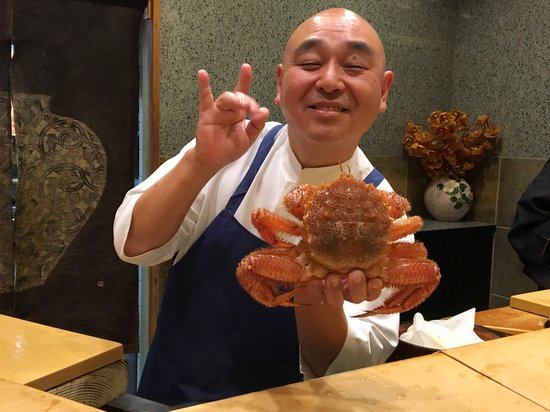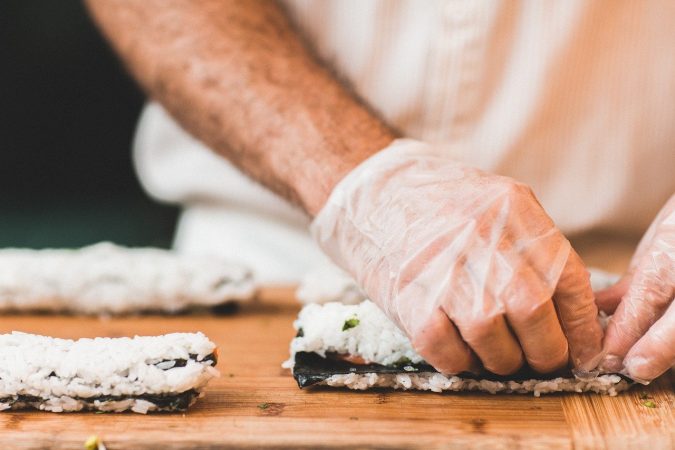Japanese cuisine has long won the love of the world: we all can not imagine any holiday without sushi and rolls. And at the same time, the profession of sushi is becoming more and more popular. The cooks, who cook sushi, learn this skill for more than a decade, and some – and devote their whole lives to this cause. Today we will tell you about the most talented chefs, who have made a name for themselves not only in Japan but all over the world.
Jiro Ono

Perhaps even the one who is not too fond of Japanese cuisine has heard about Jiro. He is not just a master of sushi, he is a real fan of his business. All his life he devoted to working in a restaurant and cooking sushi. Jiro was born to a poor Japanese family in 1925. Today he is 94 years old, but he continues to work in his own restaurant at the Tokyo underpass crossing.
We have already written about Jiro Ono’s style of work and his restaurant in our blog. In short: his restaurant, which was awarded 3 stars by the Michelin Guide in 2011, has only 10 seats, and orders from visitors are accepted only for drinks – sake, beer or tea. All of Jiro’s sushi is prepared by hand, watching the visitors. In the process of cooking sushi, Jiro is guided only by his own fantasy and the presence of fish in his kitchen.
But, it should be noted that in late 2019, Michelin excluded Jiro from its guide. The reason for this decision is not that his sushi has not become as tasty as it used to be. The fact is that lately it has become impossible to get into his restaurant: the seats are booked almost a year in advance. According to the Michelin Guide, this is against their rules, because in their guide they recommend those places where anyone can have lunch.
Katsu Nakaji

Katsu Nakaji and his wife own a small restaurant on the outskirts of Tokyo, which Michelin marked with two stars. Their restaurant features not only the highest quality sushi, but also an extremely unusual approach: Katsu not only cooks and serves exceptional dishes, but also teaches the public how to eat them.
Restaurant Katsu Nakaji’s meal is more like a lecture or a performance: places are reserved for a certain time and cannot be late. When all guests have taken their seats, Katsu presents to his guests a picture. Yes, there is no mistake. The cook believes that rice is the most important component of sushi and a direct participant in every evening. Right in front of the guests, he adds to the freshly cooked rice a filling station according to his author’s recipe, and then begins to cook sushi. According to him, for each type of fish and seafood rice should be of a special temperature. For example, for sushi with tuna rice should be no more, no less than 28 degrees Celsius (because this is the body temperature of live tuna). That’s why in the first place he cooks for guests those sushi for which he needs warmer rice, and then moves on to those for which he should cool down.
Another distinctive feature of the restaurant Katsu Nakaji is that it does not follow the traditional canons of sushi cooking: it can put two pieces of tuna on sushi, or add fried mushrooms to the eel. And to the form of sushi, it is not too strict. One of his specialties is sushi with an oyster: he simply puts the rice in the sink, right on top of the oyster.
Also, the owners of the restaurant teach all their visitors not to eat sushi at once, and first put rice up in your mouth so that fish or seafood were on your tongue, hold your breath for 5 seconds to feel the taste of the product, and only then chew and swallow.
Masahiro Yoshitake

Unlike other chefs we have already mentioned, the restaurant Masahiro Yoshitake is located in the heart of Tokyo, in one of the most popular shopping areas. Three Michelin stars, eight seats and just one chef who tried to turn the traditional idea of serving sushi into a reality.
Masahiro Yoshitake’s calling card is his signature snacks, which start any lunch at his restaurant. Boul with fried matsutake mushrooms, seafood with abalone liver sauce, sea urchins with Sichuan pepper are just the beginning. It is always followed by serving 15 sushi, and at the end of the meal – a compulsory dessert.
The cook himself always works in the omakase style, traditional for most Japanese restaurants. Omakase – in translation from Japanese means “I rely on you”. It means that you won’t accept an order for this or that dish here, the guests will have to fully trust the chef: only he here decides what dishes to cook and in what sequence to serve.
Another important detail in Yoshitake’s work is his way of cooking rice. Yoshitake cooks rice in the classic Edomae style – boiled rice is dressed with red rice vinegar and soy sauce. For his dishes, he chooses only seasonal fish, which he personally orders from the fishermen, rather than buying at the market.
Each of these great cooks spent almost all their life in the kitchen, dedicating all their free time to improving their skills. Each of them had their own long way, which led them to world recognition and Michelin stars. All three cooks, about whom we spoke today, prove that a real sushi chef should not only be able to cook sushi, but also be able to understand the combinations of flavors without fear of experiments.
Masaaki Koyama

Masaaki Kojama is Tasmania’s most famous sushi chef and one of the best sushi chefs in Australia to live his dreams with his popular sushi bar known as Masaaki’s. His bar opens only twice a week, each time it is sold because its sushi is so attractive, rich and delicious.
Many Tasmanians never tasted Japanese food until Koyama opened his sushi-ya. He started with tempura, vegetables, and various kinds of westerned sushi before making dishes from raw fish. Many Australians travel from other states to taste Koyama’s sushi.
For his sushi, he uses only fresh products, grows his own vegetables, buys fresh products from the market and catches fish at sea.
